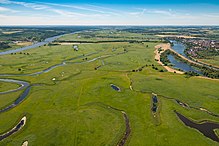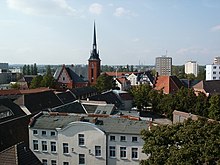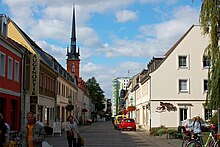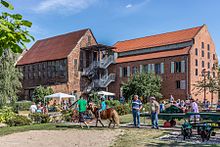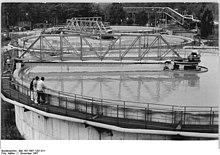Schwedt / Oder
| coat of arms | Germany map | |
|---|---|---|
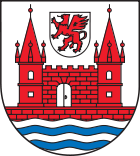
|
Coordinates: 53 ° 3 ' N , 14 ° 17' E |
|
| Basic data | ||
| State : | Brandenburg | |
| County : | Uckermark | |
| Height : | 4 m above sea level NHN | |
| Area : | 205.57 km 2 | |
| Residents: | 29,680 (Dec. 31, 2019) | |
| Population density : | 144 inhabitants per km 2 | |
| Postal code : | 16303 | |
| Primaries : | 03332, 033336 | |
| License plate : | UM, ANG, PZ, SDT, TP | |
| Community key : | 12 0 73 532 | |
| LOCODE : | DE SDT | |
| City structure: | 5 districts, 10 districts | |
City administration address : |
Dr.-Theodor-Neubauer-Straße 5, 16303 Schwedt / Oder | |
| Website : | ||
| Mayor : | Jürgen Polzehl ( SPD ) | |
| Location of the city of Schwedt / Oder in the Uckermark district | ||
Schwedt / Oder [ʃveːt] is a town in the Uckermark district . It is one of the medium-sized centers in Brandenburg .
In 2008, after eight national park communities , Schwedt was the first city in Germany to be awarded the title of National Park City , which has also been the city's official nickname since 2013. The name refers to the Lower Oder Valley National Park .
geography
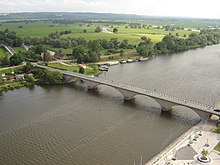
Schwedt / Oder is located in the east of the Uckermark , a landscape rich in lakes between the Lower Oder and the Upper Havel . The Uckermark is characterized by ground moraine plates and terminal moraine hills left by the Ice Age . The city was built on a sand terrace , which is only slightly above the extensive polders of the Oder valley . On the east bank of the Oder, opposite Schwedt, there are strikingly steep slopes of the terminal moraine arc on the Polish side. Between the city and the Oder, the Hohensaaten-Friedrichsthaler Wasserstraße , a canal, runs parallel to the border river as part of the Havel-Oder waterway .
Between the Oder and the Hohensaaten-Friedrichsthaler Wasserstraße there is a natural meadow landscape with a wealth of flora and fauna that is extremely rare in Central Europe. This area was declared a National Park Lower Oder Valley in 1995 . The area of the city is due to the large natural areas with approx. 200 km² about as large as that of Hanover or Magdeburg .
City structure
According to its main statute, the city of Schwedt / Oder is divided into districts and districts.
- Districts
|
|
- Districts
|
|
The residential spaces also belong to Schwedt
|
|
history
prehistory
There are traces of prehistoric settlement in the area around Schwedt (Bronze Age approx. 1000 BC).
Germanic tribes ( Semnones , tribal people of the Suebi ) populated the area since the Bronze Age.
middle Ages
On August 23, 1265 Schwedt was confirmed in writing for the first time in a document.
In 1354 Ludwig the Römer ceded Schwedt to Pomerania and from 1428 to 1432 leased it to the court banker of the Pomeranian dukes, Rule Lindstedt , for 2,400 Stettiner pfennigs.
Early modern age
In 1481 Johann I von Hohnstein acquired the Schwedt rule. The city experienced an initial boom through the Hohensteins. In particular, roads, bridges and dams were built. Shortly after each other, the Oderzoll (1505) and the town charter (1513) were renewed. Vierraden received its own town charter in 1515 based on the Schwedt model . But church things were also enforced: the Reformation and the refurbishment of the Katharinenkirche. In 1587 the town charter was renewed again. With the death of Martin von Hohenstein , the Thuringian rulers died out in 1609, and at the same time Schwedt's first glamorous period came to an end.
Schwedt was not spared from the Thirty Years' War either , as the city was an important intersection of the roads from Stettin and Prenzlau to Berlin and Frankfurt (Oder) . Schwedt was plundered 32 times in almost twenty years. In 1626 Schwedt and Vierraden provided 25 and nine armed knights with servants for the state contingent, respectively. In 1631 the field camp of the Swedish King Gustav Adolf was near Schwedt. In 1637 Schwedt was occupied again by imperial mercenaries. The Swedes, led by General Banér , demanded surrender, but they did not give in. So the general shot incendiary balls at the city, so that it went down in flames. In the end there were probably only 26 citizens who stayed there.
After the Thirty Years' War, Friedrich Wilhelm (the Great Elector) pledged Schwedt to Count Varrenbach for 25,000 thalers due to lack of money . He wanted to get as much profit as possible from his pawn and suppressed the population. When the success did not meet his expectations, he ceded the rule for 26,500 thalers to the second wife of the "Great Elector", Dorothea . With the purchase of further noble residences, Schwedt became so large that it included three cities, three castles, 33 villages and 24 farms .

Electress Dorothea devoted herself intensively to the reconstruction of the Schwedt Castle , which was damaged in the Thirty Years War , and to the economic development of the city. So she recruited a Dutch specialist who, in the spring of 1686, established the tradition of tobacco growing in the Uckermark region with the French Huguenots who had settled there. At the end of the 18th century, the Uckermark was the largest contiguous tobacco growing area in Germany with 4,400 hectares of cultivation area. With three cigar factories, tobacco was the most important economic factor in Schwedt. The last tobacco-processing operation ( VEB raw tobacco Schwedt , founded in 1953) was shortly after the turn of closed 1989/1990 and several years later completely removed. Today only a few tobacco fields and unused tobacco barns refer to this tradition. The tobacco museum in the Vierraden district, with the largest collection of tobacco growing in the region, is housed in a listed tobacco barn.
There was already Jewish life in Schwedt in the 17th century , because the Jewish cemetery in the Helbigstrasse / Schulweg area, which has survived to the present day and can be visited, dates from this time .
In 1689 Schwedt became the residence of the Margraves of Brandenburg-Schwedt , a branch of the Hohenzollern family , and in 1788 this rule was extinguished.
enlightenment
On October 6, 1713, King Friedrich Wilhelm I and the Russian General Menshikov signed a peace treaty after West Pomerania came into Prussian possession.
In 1744, the future Tsarina Catherine II of Russia stayed in Schwedt.
During the Seven Years' War , Russian Cossacks advanced as far as Schwedt several times .
The last Margrave Friedrich Heinrich (1771–1788) made Schwedt a city of culture. He set up one of the first theaters in Germany in the orangery of the Schwedt Palace. The first singing and drama took place here. Only part of the garden and the Monplaisir hunting lodge are preserved from the baroque complex .
1800 to 1945
On June 25, 1812, 37 Jewish families were declared "residents".
In 1815 the Schwedt Dragoon Regiment acquired the "Schwedt Eagle" as a traditional badge in the campaign against Napoleon (Schwedt was a garrison town from 1770 to 1937).
The Schwedt gas works was built in 1865, and in 1873 the city got a railway connection (to and from Angermünde ). The connection to the telephone network took place in 1893, to the sewerage and water network in 1908. Between 1904 and 1932 extensive hydraulic engineering measures were carried out in the lower Oder Valley with the aim of flood protection, the provision of agricultural land and the Hohensaaten-Friedrichsthaler waterway.
Swedter Jews built their synagogue at Harlanstrasse 1 in 1862 , which the National Socialists were unable to set on fire in 1938 because of the danger to the surrounding houses, but closed and later demolished, and in 1868 a mikveh was built in Gartenstrasse behind the city wall, which after it was buried 1993 was made accessible again.
In the First World War , Schwedt had 240 casualties.
Schwedt at the end of the Second World War
At the end of the Second World War , Schwedt was fiercely fought for over two months. SS-Obersturmbannführer Otto Skorzeny was deployed here. On January 31, 1945, he formed a bridgehead east of the Oder around Niederkränig with some thrown together associations . A counter-offensive against the Red Army was to be initiated from there later , but it never materialized. Skorzeny was replaced on February 28, 1945. In the last few days Schwedt was declared a fortress. His successor had to give up the fortress and bridgehead on March 3, 1945. On April 26, 1945 the Red Army took Schwedt. As a result of the fierce fighting, the city was 85 percent destroyed; the lock was burned out and the canal bridge blown up.
Schwedt after 1945
The city grew during the GDR era; Thanks to the connection to an oil pipeline, several industries emerged here. In 1959 the foundation stone for the construction of the paper mill, now LEIPA Georg Leinfelder GmbH, was laid, and in 1960 the Schwedt oil processing plant (now the PCK refinery ) was inaugurated. After the friendship (Druzhba) oil pipeline from the Ural region, which is over 3,000 kilometers long, was put into operation in 1963 , the plant mainly produced fuels from 1964 onwards . The “ Schwedt Initiative ” started in the 1980s from the refinery, which was converted into a combine at the end of 1970 . In 1975 the Schwedt shoe factory started production. This company no longer exists today. Because of the population growth, several new residential areas were built between 1960 and 1990, the population peaked at just under 54,000. The ruins of the Schwedt Castle fell victim to the restructuring measures in 1962 : the city administration had the Schwedt cultural center built on the same site in 1978 (today: Uckermärkische Bühnen Schwedt).
Within the GDR, Schwedt was synonymous with the oil industry, but also with military justice. Since 1964, the Ministry of Justice has been imprisoning soldiers who have “conspicuously” or had committed criminal offenses in former workers' barracks, which were later converted into prison, on the outskirts near the refinery. This “special camp”, officially established in 1968, was the only military prison in the GDR . Within the NVA and conscientious objectors the zip code was of Schwedt, "133" as synonymous with harsh penalties, even in Bagatellvergehen as in the case of Klaus Auerswald: He had a soldier critical of the invasion of Soviet troops in 1968 in Prague expressed. From 1982 onwards, with the establishment of a “ disciplinary unit ”, the conditions of detention were tightened . The internals of the prison were largely secret. The historical processing took place u. a. since 2008 in a research project of the Federal Commissioner for Stasi Records .
Schwedt after 1989
The city became the shopping city for the entire region in 1994 with the opening of a supraregional shopping center and several shopping arcades. In the same year the construction of a new sports hall began. In 1996 the largest cinema in the Uckermark was built (opened as “CineStar”), which, after being briefly closed in 2006, continues to be operated as the “FilmforUM” by the previous operator of the Technischen Werken Schwedt. The leisure and adventure pool “AquariUM” was inaugurated in 1999.
The flood of the Oder in 1997 did not reach Schwedt, also thanks to the large polder areas. In 2001 the newly built Schwedt harbor was opened.
Schwedt had to deal with various problems since the political change. Although the city is described as one of the few surviving “industrial cores”, the unemployment rate is 19.4% (December 2007, source: City of Schwedt / Oder). Schwedt has lost almost a third of its population since 1989. The forecasts assume that the population will decline by a further 20% by 2030. The immense vacancy rate led to whole rows of streets being torn down. On the other hand, a whole belt of single-family homes was built. The streets and the entire structure have been largely renovated, so Schwedt has a much more pleasing appearance today than it used to be.
In 1993, the documentary “The city belongs to us” drew attention to the city's problem with violent neo-Nazis in the city. Schwedt hit the headlines in July 2011 when Ibraimo Alberto, the city's former commissioner for foreigners, resigned from his post because of repeated racially motivated attacks on him.
Administrative history
Schwedt belonged to the Angermünde district from 1817 to 1952 (until 1947 in the Prussian province of Brandenburg , 1947–1952 in the state of Brandenburg ). 1952–1961 the city was part of the Angermünde district in the GDR district of Frankfurt (Oder) . On September 17, 1961 Schwedt was spun off from the Angermünde district and formed its own urban district until 1993 , and again in the state of Brandenburg from 1990. As a result of the district reform in Brandenburg in 1993, the independent city of Schwedt was incorporated into the Uckermark district.
Incorporations
In 1974 Heinersdorf was incorporated. In 1993 the three municipalities of Blumenhagen, Gatow and Kunow followed. On January 1, 1998, the official municipality of Kummerow was incorporated into the city of Schwedt / Oder and left the office of Oder-Welse . On August 1, 2001, the municipalities of Zützen and Criewen, which were also part of the office, were incorporated and also left the office of Oder-Welse. On December 31st, the municipality of Stendell, which was part of the Oder-Welse office, was incorporated. With the municipal reform in Brandenburg , the town of Vierraden , which belongs to the Gartz (Oder) district , was incorporated into Schwedt / Oder on October 26, 2003. The incorporation of the municipality of Hohenfelde, which is also part of the Gartz (Oder) office, into the city of Schwedt / Oder was approved in an announcement by the Ministry of the Interior on March 17, 2003, but only came into effect with the local elections on October 26, 2003.
| Former parish | date |
|---|---|
| Blumenhagen | December 6, 1993 |
| Criewen | August 1, 2001 |
| Gatow | December 6, 1993 |
| Heinersdorf | 1st January 1974 |
| Hohenfelde | October 26, 2003 |
| Kummerow | January 2, 1998 |
| Kunow | December 6, 1993 |
| Stendell | December 31, 2002 |
| Quadricycle | October 26, 2003 |
| Use | August 1, 2001 |
Population development
|
|
|
Territory of the respective year, population from 2011 based on the 2011 census
Up to 1981 these are mostly census results (¹), then official updates from the State Statistical Office.
religion
- Evangelical Free Church Congregation (Baptists)
- Evangelical parishes
- Evangelical Christ Church Schwedt (part of the Chrischona community organization, an evangelical community association)
- Adventist Church
- Johannische Church
- New Apostolic Church
- Roman Catholic parish
The table shows the distribution of residents according to their religious affiliation.
| Denomination | 2011 | 2017 |
|---|---|---|
| Evangelical | 9.6% | 8.3% |
| Roman Catholic | 2.9% | 3.3% |
| Other and without | 87.5% | 88.4% |
politics
City Council
The city council of Schwedt consists of 32 city councilors and the full-time mayor.
| Party / group of voters | Seats |
|---|---|
| SPD | 11 |
| AfD | 5 |
| CDU | 4th |
| The left | 4th |
| FDP | 2 |
| Brandenburg United Citizens Movements / Free Voters | 2 |
| Alliance 90 / The Greens | 2 |
| Free parliamentary alliance | 1 |
| Independent community of citizens | 1 |
(As of: local election on May 26, 2019)
→ Results of the local elections in Schwedt / Oder
mayor
(from 1961 to 1993: Lord Mayor)
- 1943–1945: Wilhelm Schrader-Rottmers (acting)
- May to November 1945: Walter Ziegelsdorff
- 1945–1951: Michael Wolter
- 1951–1955: Albert Bartel
- 1955–1961: Erwin Hartmann
- 1961–1965: Klaus-Dieter Hahn
- 1965–1968: Hermann Mattscherodt
- 1968–1979: Klaus-Dieter Hahn
- 1979–1983: Manfred Sader ( SED )
- 1983–1987: Detlef Klose
- 1987–1988: Manfred Meier
- 1988–1990: Detlef Klose
- 1990-2005: Peter Schauer ( SPD )
- since 2005: Jürgen Polzehl (SPD)
Polzehl was elected in the mayoral election on September 22, 2013 with 79.1% of the valid votes for a further term of eight years (turnout 59.8%).
badges and flags
The coat of arms was approved on May 20, 1994.
- Description of coat of arms
- “In silver above a corrugated shield base with two blue corrugated beams on a wall plinth, a red castle, on the two side round towers of which two open windows and a knotty pointed roof with three branches are attached; In the tinned connecting wall there is a closed silver gate on the right side . A silver shield with a red griffin hovers between the towers. "
- Flag description
- "The flag of the city of Schwedt / Oder is red and white striped with the city coat of arms in the middle."
administration
Schwedt is the only municipality in Brandenburg to have its own municipal credit institute, Stadtsparkasse Schwedt .
Town twinning
Schwedt maintains the following partnerships:
Sights and culture
Buildings
|
|
See also: List of architectural monuments in Schwedt / Oder
Jewish mikvah from 1868, Gartenstrasse
Historical monuments
- Plaque in Stengerhain on Bahnhofstrasse for the slain army deserter Kurt Flöter, the mayor of Konigsberg in Neumark was
- Grove of honor for anti-fascists on the New Cemetery on Vierradener Chaussee
- Memorial plaque on Harlanstrasse 1 in memory of the synagogue of the Jewish community that was destroyed in the November pogrom in 1938
- Schwedt military prison : open-air exhibition at the historic location
city Park
The city park is located in the center of the old town on the site of the former city cemetery. Between 2008 and 2011, the city exhibited contemporary works by Schwedter and foreign artists, including works by Axel Schulz , Jo Jastram and Peter Fritzsche .
theatre
- UBS - Uckermärkische Bühnen Schwedt
- Stolperdraht theater (children's and youth theater in Schwedt e.V.)
Museums
City museums Schwedt / Oder with:
- City Museum, Jüdenstrasse 17
- Jewish Museum with Ritual Bath, Gartenstrasse 6
- Tobacco Museum in the Vierraden district, Breite Straße 14
Galleries
- Gallery at the Kietz
Flinkenberg
In the garden pond of the former orphanage on Fabrikstrasse was the Flinkenpfuhl , which dates back to the Ice Age and was named after the young fish of the lead , the Swift. The Flinkenpfuhl had a natural connection to the Oder via the Spitelgraben. From this geographical situation it can be deduced from where the hill in the triangle Catholic Church - Jüdenstraße - Harlanstraße got the name Flinkenberg originally. The former Flinkenberg street, which was built after the city was founded in the Middle Ages, was merged with the then Viehmarktstraße on November 17, 1945 and expanded to include the Hirten- und Viehmarktstraße as far as Berliner Straße. According to plans from 1744, a splendid church of the French Reformed Church was to be built on Flinkenberg. However, the building project was realized three years later as the Berlischky Pavilion on today's Lindenallee.
Economy and Infrastructure
economy
The city's economy is dominated by the PCK refinery , which owns around ten percent of Germany's oil processing capacities. Connected to it is the Schwedt mineral oil network , which picks up the oil arriving here via the friendship pipeline and forwards it to the PCK refinery and the Total Refinery Central Germany in the Leunawerke .
The VERBIO Ethanol Schwedt GmbH operates Europe's first bioethanol plant , which is directly on the site of an oil refinery. It is extracted from rye ethanol and biomethane has been produced from straw since 2014 .
Another important economic factor is the paper industry with the three companies Georg Leinfelder Werk Süd (LEIPA) , Werk Nord (formerly UPM) and Brandenburger Tapeten Schwedt with around 1 million tons of waste paper processing annually and thus the second largest paper production location in Germany. The business location is one of 15 regional growth centers in the state of Brandenburg. This promotes selected future-oriented industries.
traffic
- In Schwedt the federal highways B 2 cross between Angermünde and Gartz (Oder) and the B 166 between the Uckermark cross and the Schwedt – Krajnik Dolny border crossing to Poland.
- The station Schwedt (Or) and the breakpoint Schwedt (Or) center on the route Angermuende-Schwedt be from the regional express line 3 Schwedt Berlin-RE Wittenberg and the Regional line RB 61 Schwedt- Angermuende operated.
- The PCK refinery is connected to the Berlin-Stettin line via the Passow – Schwedt railway line
- Schwedt harbor on the Hohensaaten-Friedrichsthaler waterway (connection to Oder and Havel)
- Oder-Neisse cycle path with connection to Ahlbeck (Heringsdorf) or Zittau
- Uckermärkischer cycle path with connection to Prenzlau , Templin and Angermünde
Public facilities
- Asklepios Klinikum Uckermark (focus on care)
State institutions
- District court Schwedt / Oder
- Federal Central Tax Office (BZSt), Schwedt / Oder office
Educational institutions
- Carl-Friedrich-Gauß-Gymnasium
- Triad High School
- Comprehensive school "Talsand" (with upper school level)
- Elementary school "Bertolt Brecht"
- Astrid Lindgren Elementary School
- Erich Kästner Elementary School
- Primary school "Am Waldrand"
- Music and art school "JAP Schulz"
- Upper school center Uckermark
- General special school "Am Schloßpark"
- Special school for the mentally handicapped "Im Odertal"
- Adult Education Center Schwedt / Oder
- Evangelical primary school Schwedt
Leisure and sports facilities
- Schwedt castle garden
- Kino FilmforUM
- Leisure and adventure pool (FEB) "AquariUM"
- Bowling center
- Dirt bike park
- Ice arena
Personalities
sons and daughters of the town
- Urban Pierius (1546–1616), Protestant theologian
- Friedrich Wilhelm (1700–1771), Margrave of Brandenburg-Schwedt
- Heinrich Friedrich (1709–1788), Margrave of Brandenburg-Schwedt, Prince of Prussia
- Wilhelm Heinrich Adolf von Kalckreuth (1735–1811), Prussian lieutenant general
- Friederike Dorothea Sophia of Brandenburg-Schwedt (1736–1798), by marriage Duchess of Württemberg
- Anna Elisabeth Luise von Brandenburg-Schwedt (1738–1820), by marriage Princess of Prussia
- Georg Wilhelm Berlischky (1741–1805), architect
- Philippine von Brandenburg-Schwedt (1745–1800), by marriage Landgrave of Hessen-Kassel
- Friederike Charlotte von Brandenburg-Schwedt (1745–1808), last princess of the Herford Abbey
- David Gilly (1748-1808), builder
- Eugene of Württemberg (1758–1822), Duke of Württemberg
- The Harlan brothers (* around 1787), builders of the tobacco factory in Schwedt
- Ludwig Leopold Liebig (1801–1872), gardener and plant breeder
- Albert Schulz (pseudonym San-Marte; 1802–1893), administrative lawyer and writer
- Adolph Schroedter (1805–1875), painter
- Leonhard von Blumenthal (1810–1900), Field Marshal General
- Rudolf von Bitter the Elder (1811–1880), President of the Royal Prussian Maritime Trade
- Karl Hermann Bitter (1813–1885), statesman and music writer
- Maximilian von Philipsborn (1815–1885), politician and diplomat
- Ludwig Jacobi (1816–1882), member of the Reichstag and Landtag
- Karl von Schmidt (1817–1875), cavalry commander
- Paul von Bojanowski (1834–1915), journalist, librarian and writer
- Friedrich August von Holstein (1837–1909), diplomat
- Axel von Colmar (1840–1911), Prussian civil servant
- Fritz Dörge (1848–1928), painter
- Konrad von Hausmann (1853–1923), general of the cavalry
- Otto Julius Quehl (1857–1914), doctor and writer
- Joachim von Heydebreck (1861–1914), Prussian lieutenant colonel
- Paul von Hintze (1864–1941), rear admiral and diplomat
- Max Dawison (1869–1953), opera singer (baritone)
- Johann Fiehn (1875–1939), government builder , district administrator and police director
- Fritz Conrad (1883–1944), naval officer, most recently rear admiral in World War II and head of research
- Max Lemke (1895–1985), major general in the Wehrmacht
- Heinz von Cleve (1897–1984), actor
- Horst Wendlandt (1922–2002), film producer
- Hans-Georg Kuhn (1924–2018), politician (CDU) and member of the Hamburg Parliament
- Gerhard Gottschalk (* 1935), microbiologist
- Klaus C. Plönzke (* 1936), IT entrepreneur
- Hagen Boßdorf (* 1964), journalist
- Holger Boche (* 1966), engineer and mathematician
- Annett Müller (* 1968), songwriter
- Jörg Hoffmann (* 1970), swimmer
- Thomas Rath (* 1970), football player
- Julia Brendler (* 1975), actress
- Danilo Häußler (* 1975), professional boxer
- Marko Werner (* 1976), actor
- Oliver Glöden (* 1978), soccer player
- Turid Arndt (* 1981), handball goalie
- Melanie Wolgast (* 1981), foil fencer
- Britta Steffen (* 1983), swimmer and two-time Olympic champion in 2008
- Péter Vida (* 1983), politician (BVB / Free Voters)
- Franziska Wulf (* 1984), actress
- Benjamin Berger (* 1986), actor
- Philipp Boy (* 1987), artistic gymnast
- Caroline Hamann (* 1987), soccer player
- Julia Richter (* 1988), rower, 2011 world champion in quadruples
- Sebastian Brendel (* 1988), canoeist, Olympic champion 2012, two-time Olympic champion 2016
- Rick Okon (born 1989), actor
- Pia Hildebrand (* 1991), handball player
- Jan Vandrey (* 1991), canoeist and Olympic champion 2016
- Denise Imoudu (* 1995), volleyball player
- Sophie Dreblow (* 1998), volleyball player
- Natalie Wilczek (* 2000), volleyball player
Personalities associated with Schwedt
- Otto Leopold Ehrenreich von Gloeden (1731–1801), Prussian major general, commander of the Dragoons
- Johann Abraham Peter Schulz (1747–1800), musician and composer
- Herbert Brumm (pseudonym Harry Bär) (1909–1985), writer and photographer
- Axel Schulz (1937–2012), sculptor
literature
- Felix Freiyhoff: Schwedt on the Oder . With twelve illustrations. In: Vom Fels zum Meer 22nd vol., Vol. 2, 1903, pp. 1113–1118.
- Lieselott Enders : Historical local dictionary for Brandenburg, Part VIII, Uckermark. Becker, Potsdam 1986, ISBN 3-7400-0042-2 .
- Lutz Libert: Schwedt in old views. 3 volumes, Zaltbommel / Netherlands 1996, ISBN 90-288-6281-1 .
- Hans-Jörg Wilke: Schwedt on the Oder. Sutton, Erfurt 2003, ISBN 3-89702-593-0 .
- Günther Ballentin: The destruction of the city of Schwedt / Oder 1945. Self-published, Berlin-Neukölln 2005, DNB 983512620 .
- Iris Berndt: The former Schwedt castle garden. City administration Schwedt, Schwedt 2005, DNB 97892259X .
- Philipp Springer: Built-in dreams. Dominion, urban development and the reality of life in the socialist industrial city of Schwedt. Christoph Links Verlag, Berlin 2006, ISBN 3-86153-396-0 .
- Edition Brandenburg: Then and Now - Schwedt / Oder. Berlin / Wildeshausen 2010, ISBN 978-3-941092-37-2 .
- Chronicle of the city of Schwedt / Oder - in data, documents and pictures, 2011, ISBN 978-3-00-033298-2 .
- Rüdiger Wenzke: Off to Schwedt! History of the GDR military penal system. Christoph-Links-Verlag, Berlin 2011, ISBN 978-3-86153-638-3 .
- Arno Polzin: The Schwedt myth. GDR military penal system and NVA disciplinary unit from the perspective of the State Security . Vandenhoeck & Ruprecht, Göttingen 2018. ISBN 978-3-525-35126-0 .
Web links
- Official website of the city of Schwedt / Oder
- Prussia in Schwedt
- A city is shrinking healthily. on: Spiegel Online. September 10, 2006.
- Portal Schwedt - information and pictures
Individual evidence
- ↑ Population in the State of Brandenburg according to municipalities, offices and municipalities not subject to official registration on December 31, 2019 (XLSX file; 223 KB) (updated official population figures) ( help on this ).
- ↑ Max Mangold: The pronunciation dictionary. Duden Volume 6. Mannheim / Zurich 2005: Dudenverlag. ISBN 978-3-411-04066-7 .
- ↑ Schwedt / Oder: National Park City 2008
- ↑ Schwedt / Oder: New entrance sign revealed
- ^ Message from the Brandenburg Ministry of the Interior
- ↑ Main statutes of the city of Schwedt / Oder from January 28, 2009 Archived copy ( memento of the original from April 6, 2017 in the Internet Archive ) Info: The archive link has been inserted automatically and has not yet been checked. Please check the original and archive link according to the instructions and then remove this notice.
- ^ Service portal of the state administration of the State of Brandenburg - City of Schwedt / Oder
- ↑ Carola Nathan: Evidence of Jewish Life in Schwedt - Against Forgetting. In: Monuments - magazine for monument culture in Germany. June 2010, accessed May 17, 2015 .
- ↑ Brigitte Heidenhain: Jews from Schwedt - their life in the city from 1672 to 1942 and their cemetery . Universitätsverlag Potsdam, Potsdam 2010, ISBN 978-3-86956-050-2 ( online ).
- ^ Otto Skorzeny: My commando company. 3. Edition. Limes Verlag, Wiesbaden / Munich 1977, ISBN 3-8090-2100-8 , p. 379 ff.
- ↑ Schwedt was deserted. In: Märkische Oderzeitung. April 27, 2005 ( Memento from September 22, 2008 in the Internet Archive )
- ↑ Klaus Auerswald: Otherwise you will come to Schwedt. Report from a military prisoner. Greifenverlag, Rudolstadt / Berlin 2010.
- ^ Arno Polzin: Myth Schwedt. GDR military penal system and NVA disciplinary unit from the perspective of the State Security . 1st edition. Göttingen 2018, ISBN 978-3-525-35126-0 .
- ↑ Foreigners commissioner flees from racism. on: stern.de , July 8, 2011.
- ↑ a b Municipalities 1994 and their changes since January 1st, 1948 in the new federal states , Metzler-Poeschel publishing house, Stuttgart, 1995, ISBN 3-8246-0321-7 , publisher: Federal Statistical Office
- ↑ Incorporation of the Kummerow community into the city of Schwedt / Oder. Announcement of the Ministry of the Interior of December 22, 1997. Official Gazette for Brandenburg Common Ministerial Gazette for the State of Brandenburg, Volume 9, Number 2, January 22, 1998, p. 23.
- ^ Incorporation of the community of Zützen into the city of Schwedt / Oder. Communication from the Ministry of the Interior dated July 11, 2001. Official Journal for Brandenburg Common Ministerial Gazette for the State of Brandenburg, Volume 12, 2001, Number 31, Potsdam, August 1, 2001, p. 550/1 PDF
- ↑ Incorporation of the community of Criewen into the city of Schwedt / Oder. Communication from the Ministry of the Interior of July 11, 2001. Official Gazette for Brandenburg Common Ministerial Gazette for the State of Brandenburg, Volume 12, 2001, Number 31, Potsdam, August 1, 2001, p. 550 PDF
- ↑ Incorporation of the community of Stendell into the city of Schwedt / Oder. Communication from the Ministry of the Interior dated August 28, 2002. Official Journal for Brandenburg Common Ministerial Gazette for the State of Brandenburg, Volume 13, 2002, Number 39, Potsdam, September 18, 2002, p. 843 PDF
- ↑ Fifth law on state-wide municipal area reform regarding the districts of Barnim, Märkisch-Oderland, Oberhavel, Ostprignitz-Ruppin, Prignitz, Uckermark (5th GemGebRefGBbg) of March 24, 2003 Law and Ordinance Gazette for the State of Brandenburg, I (Laws), 2003, No. 05, p. 82, amended by the law of July 1, 2003 (Law and Ordinance Gazette for the State of Brandenburg, I (Laws), 2003, No. 10, p. 187)
- ^ Incorporation of the Hohenfelde community into the city of Schwedt / Oder. Communication from the Ministry of the Interior of March 17, 2003. Official Gazette for Brandenburg Common Ministerial Gazette for the State of Brandenburg, Volume 14, 2003, Number 15, Potsdam, April 16, 2003, p. 417 PDF
- ↑ Historical municipality register of the state of Brandenburg 1875 to 2005. District Uckermark . Pp. 26-29
- ↑ Population in the state of Brandenburg from 1991 to 2017 according to independent cities, districts and municipalities , Table 7
- ^ Office for Statistics Berlin-Brandenburg (Ed.): Statistical report AI 7, A II 3, A III 3. Population development and population status in the state of Brandenburg (respective editions of the month of December)
- ^ City of Schwedt: Population in regional comparison by religion
- ↑ Schwedt / Oder 2017 - The City in Numbers , accessed on May 23, 2020
- ^ Result of the local election on May 26, 2019
- ↑ Mayor after 1945 on www.schwedt.eu
- ↑ Brandenburg Local Election Act, Section 74
- ^ Result of the mayoral election on September 22, 2013
- ↑ a b Coat of arms information on the service portal of the state administration of the State of Brandenburg
- ↑ a b § 2 Paragraphs 2 and 3 of the main statute of the city of Schwedt / Oder ( page no longer available , search in web archives ) Info: The link was automatically marked as defective. Please check the link according to the instructions and then remove this notice.
- ^ Website of the Sparkasse Schwedt
- ↑ Partnerships
- ^ Stadtmuseum Schwedt / Oder: Open-air exhibition on the military prison: Open-air exhibition | City Museum Schwedt / Oder. December 18, 2018, accessed February 25, 2019 .
- ↑ http://www.schwedt.eu/cms/detail.php/land_bb_boa_01.c.137846.de?_lang=de
- ↑ Junge Bleie once at home there. In: Märkische Oderzeitung. August 26, 2009.
- ↑ Birth register of the city of Schwedt, entry No. 182 from July 1, 1897.




